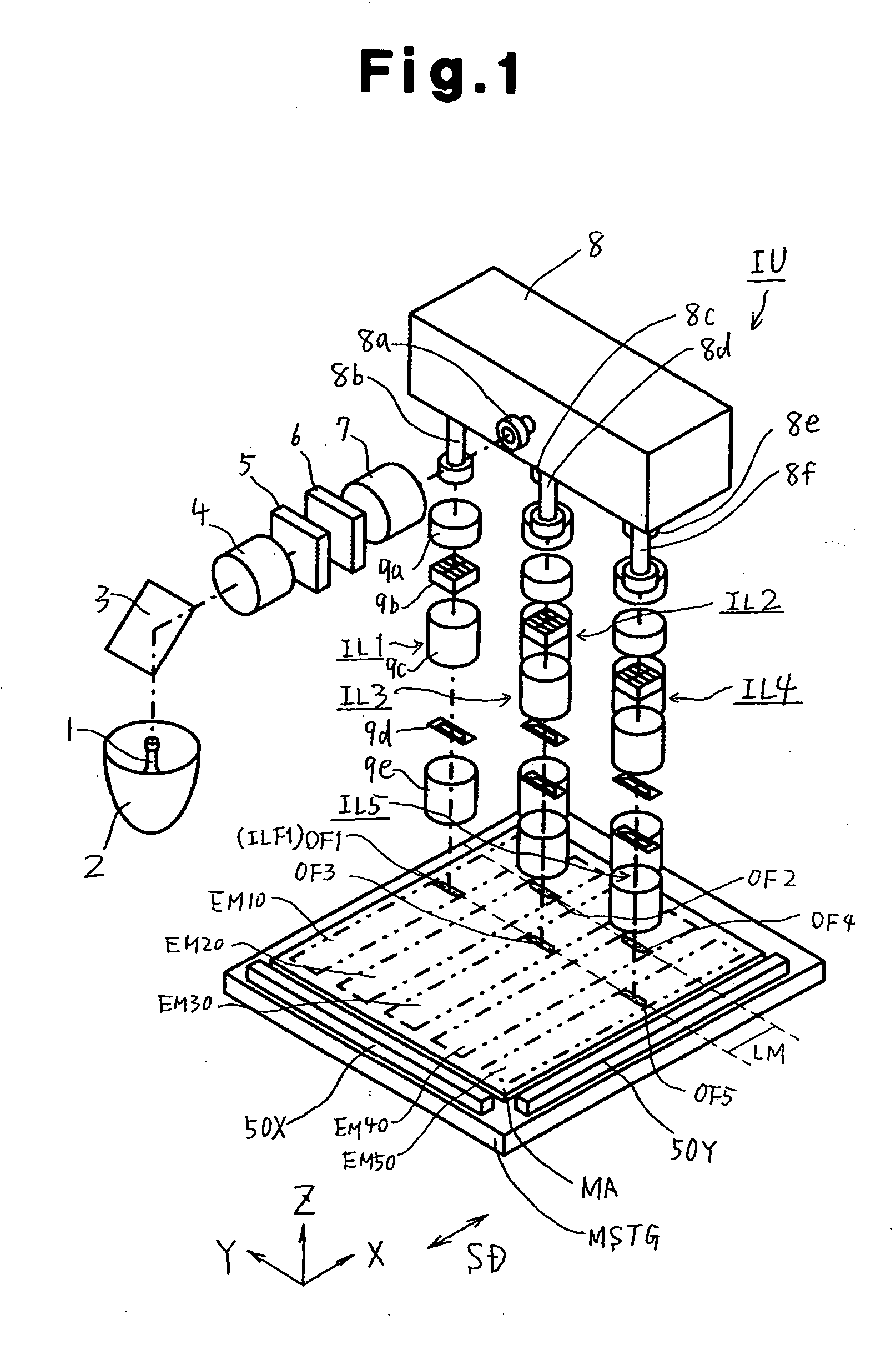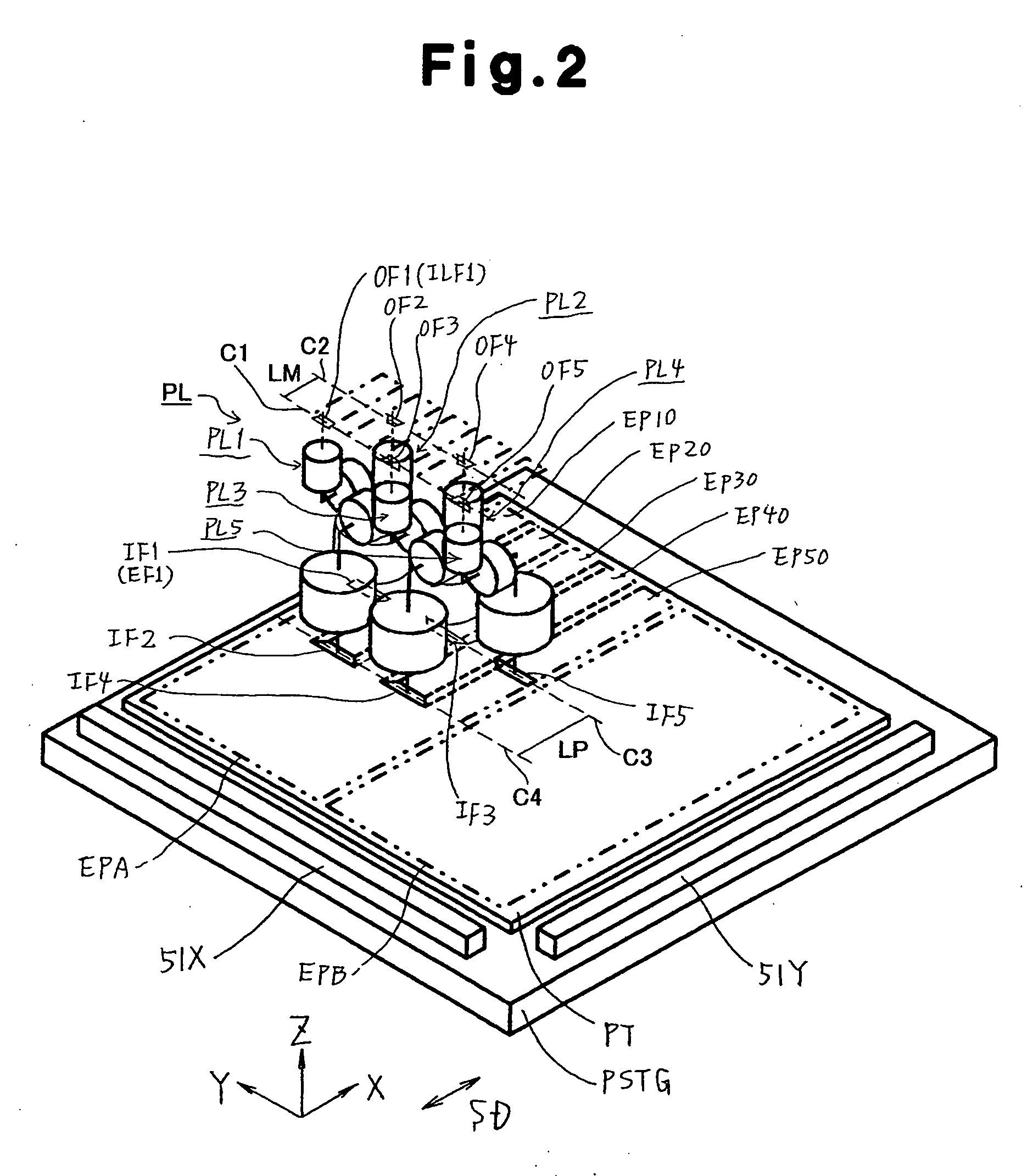Projection optical apparatus, exposure method and apparatus, photomask, and device and photomask manufacturing method
a technology of projection optical apparatus and exposure method, applied in the direction of photomechanical treatment, printing, instruments, etc., can solve the problems of further increase and higher cost, and achieve the effect of reducing image oscillation, optimum pattern transfer, and well-balanced manner
- Summary
- Abstract
- Description
- Claims
- Application Information
AI Technical Summary
Benefits of technology
Problems solved by technology
Method used
Image
Examples
first embodiment
[0047]A first embodiment of the present invention will now be described with reference to FIGS. 1 to 12.
[0048]FIG. 1 shows a schematic structure of an illumination unit and a mask stage of a scanning projection exposure apparatus employing a step-and-scan method in the first embodiment. FIG. 2 shows a schematic structure of a projection optical apparatus and a substrate stage of the projection exposure apparatus. In FIGS. 1 and 2, the projection exposure apparatus includes an illumination unit IU, a mask stage MSTG, a projection optical system PL, a substrate stage PSTG, a drive mechanism (not shown), and a control unit (not shown). The illumination unit IU illuminates a pattern of a mask MA (first object) with illumination light emitted from a light source. The mask stage MSTG holds and moves the mask MA. The projection optical system PL projects a magnified image (an image with an enlargement magnification) of the pattern of the mask MA onto a plate (substrate) PT (second object)....
second embodiment
[0102]A second embodiment of the present invention will now be described with reference to FIGS. 14 to 20. A stage system of a scanning projection exposure apparatus according to the second embodiment is similar to the stage system described in the first embodiment. However, a projection exposure apparatus of the second embodiment differs from the projection optical apparatus PL of the first embodiment shown in FIG. 2 in the shift direction and the shift amount of light beams (optical axes) of each of its projection optical systems PL1 to PL5. The components shown in FIGS. 14 to 20 corresponding to the components shown in FIGS. 1 to 5 are given the same reference numerals and will not be described in detail.
[0103]FIGS. 14(A) to 14(C) show a projection optical apparatus PLA of the second embodiment. FIG. 14(A) is a plan view showing the arrangement of a plurality of pattern fields EM10 to EM50 formed on a mask MA. FIG. 14(B) is a projection view showing the arrangement of the plurali...
third embodiment
[0133]A third embodiment of the present invention will now be described with reference to FIGS. 21 to 24. In the third embodiment, a manufacturing method for a mask on which patterns are transferred using the projection optical apparatus PL of each of the above embodiments (e.g., the mask MA in FIG. 1) will be described.
[0134]FIG. 21 is a conceptual diagram describing the positional relationship between patterns of the mask and the patterns transferred onto the plate in the embodiment shown in FIGS. 1 and 2. In FIG. 21, a mask MA1 includes a pattern field EM10 in a first row and a pattern field EM20 in a second row, which are spaced from each other in a non-scanning direction (Y-direction). The pattern fields EM10 and EM20 have a length in the longitudinal direction that coincides with a scanning direction (X-direction).
[0135]The first-row pattern field EM10 includes a first pattern field RP10, of which has a length in the longitudinal direction coinciding with the scanning directio...
PUM
| Property | Measurement | Unit |
|---|---|---|
| size | aaaaa | aaaaa |
| wavelength | aaaaa | aaaaa |
| wavelength | aaaaa | aaaaa |
Abstract
Description
Claims
Application Information
 Login to View More
Login to View More - R&D
- Intellectual Property
- Life Sciences
- Materials
- Tech Scout
- Unparalleled Data Quality
- Higher Quality Content
- 60% Fewer Hallucinations
Browse by: Latest US Patents, China's latest patents, Technical Efficacy Thesaurus, Application Domain, Technology Topic, Popular Technical Reports.
© 2025 PatSnap. All rights reserved.Legal|Privacy policy|Modern Slavery Act Transparency Statement|Sitemap|About US| Contact US: help@patsnap.com



